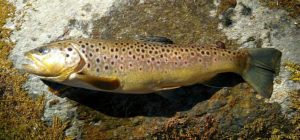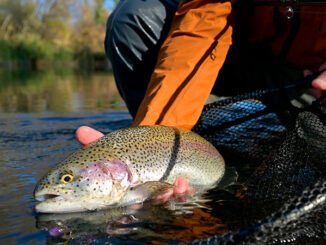
Brown trout; king of trout fishing
The brown trout is the undisputed king of trout fishing, particularly in the East where it first established a foothold.
Beautifully colored, a prodigious fighter and a challenge to catch, brown trout populate streams throughout the United States and streams and lakes throughout the world. Even in unlikely places as Afghanistan, Pakistan and South Africa.
A member of the salmon family, Salmo trutta, its markings are distinctive. Dark, red dots surrounded by halos cover its back and sides from tail to head. And an uninterrupted stretch of golden yellow covers its stomach and fins. Unlike the brook trout, a true American native, the brown is a migrant species. Fisheries biologists brought them in from Germany more than 100 years ago because of the persistence of a New York fish farmer.
The Beginnings
Fred Mather, a fish culturist and the father of brown-trout fishing in the United States, first worked with the newly formed U.S. Fish Commission in the late 1800s. He raised shad, grayling and sea bass at his hatchery in Honeoya Falls, N,Y. On a trip to Germany to deliver salmon eggs, he met Lucius von Behr, president of the German Fishing Society. Mather became intrigued with the idea of transporting brown trout eggs to America. After several unsuccessful attempts to ship them, he developed a refrigerated container to keep eggs alive during their journey from Germany.
In 1883, the U.S. Fish Commission released an initial batch of 4,900 fry in the Baldwin River in Michigan, a tributary of Pere Marquette River. The initial release was so successful that the Commission began stocking browns in other streams. Soon, everyone wanted browns. And by 1900, they populated thousands of streams in 38 states.
German browns eventually were mixed with Loch Levin browns from Scotland, and the new strain became known as the “American brown trout.” The only discernible difference in the two is that the Loch Levin browns have all dark spots on their backs and sides.
Trout Literature
Writers have been extolling the virtues of fishing for browns since 200 A.D, when a Roman, Aelian, described “a fish with speckled skin” in “On the Nature of Animals.” Thirteen hundred years later, Dame Juliana Berners of England wrote about brown trout in her “Treatyse of Fysshnge wyth an Angle” in 1496. Izaak Walton included brown trout in his “Compleat Angler” in 1653, and anglers have been writing about fishing for them ever since.
Fish for Browns

Browns can thrive in marginal waters where brook trout and rainbow trout cannot. And they grow larger, primarily because of their diverse diet. They feed on invertebrates, crustaceans, darters, sculpins, frogs, minnows and the young of other trout. The world record for a brown is 42.1 pounds, caught in New Zealand, surpassing the previous record, a 41.7-pound brown caught in the Manistee River in Michigan. The state record for South Carolina is 17 pounds, 9 ½ ounces, caught in Lake Jocassee in 1987. The North Carolina record is 24 pounds, 10 ounces, caught in the Nantahala River in 1998.
Browns prefer big water and deep pools, holding in areas with adequate hiding places to ambush their prey. Large dry flies, streamers, spinning lures, jigs and minnow imitations are the preferred lures for catching browns.
Top brown trout waters in South Carolina are Lake Jocassee, Chattooga River, Thompson River and Whitewater River. In North Carolina, notable brown trout streams are Hazel Creek, Deep Creek, Nantahala River, Toe River and Horsepasture River.
Propagation, stockings
Like brook trout, brown trout spawn in the fall, migrating to tributaries to lay thousands of eggs. Biologists say that only one egg in a thousand survives to fry size. Once they reach fingerling size, however, they mature quickly. Average life span for a brown is five years. The longest recorded lifespan is 20 years.
Browns are stocked in hatchery-supported waters in South Carolina and in hatchery-supported and delayed-harvest waters in North Carolina. South Carolina stockings are mostly fingerlings. North Carolina stockers are larger adults and are stocked in fewer numbers than brook and rainbow trout.
Whether stocked or wild, brown trout fishing offers the rare opportunity of catching a trophy-size trout, and the king of the trout world.
Click here for an article about two anglers doubling up on citation brown trout in Lake Jocassee.





Be the first to comment